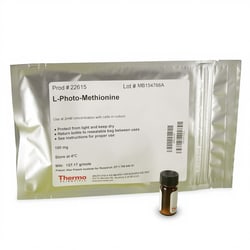Learn More
Thermo Scientific™ L-Photo-Methionine
Diazirine analogs of leucine and methionine to express proteins in cell culture that will crosslink their protein interactors upon UV-light activation in vivo.
Supplier: Thermo Scientific™ 22615
Description
Thermo Scientific™ Pierce Photoreactive Amino Acids are analogs of L-Leucine and L-Methionine that can be incorporated into proteins during synthesis and then light-activated to covalently crosslink interacting proteins in cells.
Thermo Scientific L-Photo-Leucine and L-Photo-Methionine are analogs of L-Leucine and L-Methionine amino acids that have activatable diazirine side chains capable of chemical crosslinking to adjacent molecules when exposed to ultraviolet light. Like their naturally occurring counterparts, these photo-reactive amino acids can be endogenously incorporated into the primary sequence of proteins during synthesis. Protein-protein interaction domains involving the synthesized proteins in their native environments can then be covalently crosslinked by activating the diazirine groups. Traditional crosslinking experiments require adding bifunctional chemical crosslinkers and associated reagent solvents, which can adversely affect the cell biology being studied. Using photo-reactive amino acids minimizes these potentially adverse effects and enables both stable and transient protein interactions in cells to be studied and characterized with a high degree of confidence.When used in combination with specially formulated limiting cell media that is devoid of leucine and methionine, the photo-activatable derivatives are treated like naturally occurring amino acids by the protein synthesis machinery. As a result, they can be substituted for leucine or methionine in the primary sequence of proteins. When exposed to UV light the diazirine rings become reactive intermediates that form covalent bonds with nearby protein side chains and backbones. Naturally associating binding partners are then instantly trapped. Crosslinked protein complexes are detected by decreased mobility on SDS-PAGE followed by Western blot detection, size-exclusion chromatography, sucrose density-gradient sedimentation or mass spectrometry.Highlights:
In vivo labeling – incorporate photo-reactive group into proteins using normal cellular machinery
In vivo crosslinking – find interacting proteins in the native cellular environment
Increased specificity compared to traditional methods – crosslink interacting proteins correctly positioned at their interfaces within protein interaction domains
Complementary to traditional methods – provides detailed characterization of protein interactions when compared to results with formaldehyde and other more general crosslinking approaches
Efficient recovery – 90% protein recovery in cell lysates after crosslinking
Compatible – crosslink proteins expressed in a wide variety of cell lines, including HeLa, 293T, COS7, U2OS, A549, A431, HepG2, NIH 3T3 and C6
Easy to use – reagents are photo-stable under normal laboratory lighting, eliminating the need to work in the dark
Specifications
| Nonselective-NA (Metabolic labeling) | |
| L-Photo-Methionine | |
| No | |
| Upon receipt store at 4°C protected from light. | |
| Ambient | |
| Chemical Labeling, Metabolic Labeling | |
| Diazirine | |
| Solid | |
| Water | |
| Yes |
| No | |
| 157.17 | |
| 0.0 AÌ | |
| Yes | |
| Pierce | |
| Heterobifunctional | |
| Short (<10 AÌ) | |
| 100 mg | |
| Standard | |
| Crosslinker |
For Research Use Only. Not for use in diagnostic procedures.
